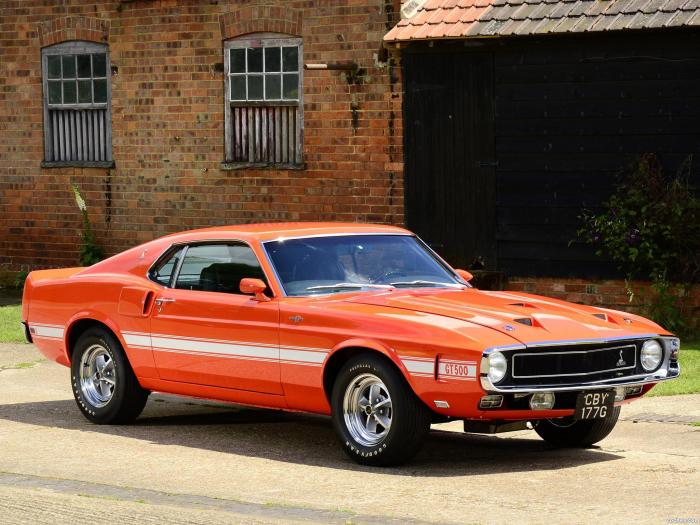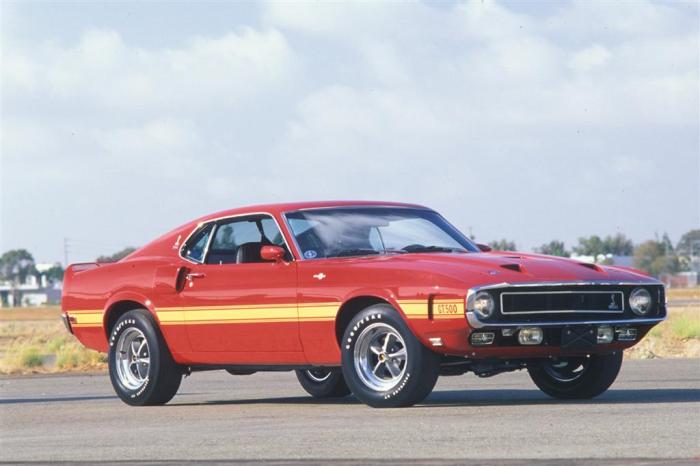The 1969 Shelby GT500, a name synonymous with American muscle car prowess, emerged as a culmination of Carroll Shelby’s vision and Ford’s engineering might. This iconic machine, a potent blend of power and style, captured the hearts of enthusiasts and cemented its place in automotive history.
The GT500’s genesis lies in the pursuit of performance, a desire to create a car that could dominate both the racetrack and the open road. The result was a masterpiece of engineering, a powerful testament to the spirit of American innovation.
Under the hood, the GT500 boasted a 7.0-liter V8 engine, capable of unleashing a staggering 335 horsepower. This potent powerplant, coupled with a robust suspension and a carefully engineered chassis, delivered an exhilarating driving experience. The 1969 GT500’s performance wasn’t just about brute force; it was about precision, agility, and a visceral connection between driver and machine.
The GT500 was more than just a car; it was a statement, a symbol of American automotive excellence.
History and Background

The 1969 Shelby GT500, a formidable muscle car, emerged from a collaboration between automotive legend Carroll Shelby and Ford Motor Company. This iconic model, with its potent engine and aggressive styling, quickly became a symbol of American automotive prowess and continues to captivate enthusiasts today.
The 1969 Shelby GT500, with its iconic Cobra Jet engine and aggressive styling, marked a high point in the Mustang’s performance lineage. While the ’69 model is renowned for its power, its predecessor, the 1968 Shelby GT500 , introduced many of the design elements that would define the later iterations.
The ’69 GT500 built upon the foundation laid by its predecessor, solidifying its place as a legend among muscle cars.
The development of the 1969 Shelby GT500 was driven by a desire to create a performance-oriented Mustang that could compete with the Chevrolet Corvette and other high-performance sports cars of the era. Carroll Shelby, known for his success in racing and automotive design, was the perfect choice to lead this endeavor.
The Birth of the GT500
Carroll Shelby, a renowned racing driver and automotive engineer, had already established a successful partnership with Ford in the early 1960s, culminating in the creation of the legendary Cobra. In 1967, Ford tasked Shelby with developing a high-performance version of the Mustang to compete with the Chevrolet Camaro and the Pontiac Firebird.
This led to the birth of the Shelby GT500.
The Design Philosophy and Key Features, 1969 Shelby GT500
The 1969 Shelby GT500 was designed to be a powerful and aggressive muscle car, incorporating a number of features that set it apart from the standard Mustang. The most notable of these was the 428 cubic-inch Cobra Jet V8 engine, capable of producing over 335 horsepower.
This engine was paired with a heavy-duty suspension, a four-speed manual transmission, and a limited-slip differential.
Carroll Shelby’s Influence
Carroll Shelby’s influence on the design and engineering of the 1969 GT500 was profound. He insisted on using the best available components and pushed the limits of performance, resulting in a car that was both powerful and capable. Shelby’s passion for racing and his commitment to excellence are evident in every aspect of the GT500.
Ford’s Contribution
Ford provided the platform for the GT500, namely the Mustang, and also contributed to the development of the powerful Cobra Jet V8 engine. Ford’s expertise in mass production ensured that the GT500 could be produced in sufficient quantities to meet the demand from enthusiasts.
The collaboration between Shelby and Ford proved to be a winning formula, resulting in one of the most iconic muscle cars of all time.
Key Features of the 1969 Shelby GT500
The 1969 Shelby GT500 was equipped with a number of features that enhanced its performance and handling. These features included:
- A 428 cubic-inch Cobra Jet V8 engine producing over 335 horsepower.
- A heavy-duty suspension with front disc brakes and rear drum brakes.
- A four-speed manual transmission.
- A limited-slip differential.
- A distinctive hood scoop.
- A rear spoiler.
- A unique grille with a Shelby Cobra emblem.
- Side scoops.
- Special badging.
Performance and Specifications: 1969 Shelby GT500

The 1969 Shelby GT500 was a powerful muscle car that offered thrilling performance and a distinctive look. It was powered by a massive engine and equipped with a range of features that made it a standout among its contemporaries.
Engine Specifications
The 1969 Shelby GT500 was powered by a 7.0-liter (428 cubic inch) Ford FE V8 engine, a powerful engine with a reputation for high performance.
The 1969 Shelby GT500, a brute of a muscle car, represented the pinnacle of Ford’s performance aspirations at the time. Its imposing presence was a direct result of Carroll Shelby’s knack for transforming ordinary cars into high-performance machines, a skill he honed with the legendary 1965 Shelby Cobra.
While the Cobra was a lightweight roadster, the GT500 embraced a different philosophy, offering raw power and a commanding presence that made it a true American icon.
- Horsepower:335 hp (250 kW) at 5,200 rpm
- Torque:440 lb⋅ft (597 N⋅m) at 3,400 rpm
- Transmission:The GT500 was offered with a 3-speed automatic transmission or a 4-speed manual transmission. The 4-speed manual was considered the preferred choice by many enthusiasts for its responsiveness and driver engagement.
Performance Compared to Other Muscle Cars
The 1969 Shelby GT500 was a formidable muscle car, capable of impressive performance.
- Acceleration:The GT500 could accelerate from 0 to 60 mph in approximately 6.5 seconds. This made it one of the quickest muscle cars of its era.
- Top Speed:The GT500 had a top speed of around 130 mph. This was a respectable figure for a muscle car of the time.
- Quarter Mile:The GT500 could cover the quarter mile in about 14.5 seconds. This was a remarkable performance for a car of its size and weight.
Handling and Driving Experience
The 1969 Shelby GT500 offered a unique driving experience.
- Ride:The GT500’s suspension was designed for performance, providing a firm but comfortable ride.
- Handling:The GT500 was a surprisingly agile car for its size. The front suspension included a sway bar, and the rear suspension featured leaf springs. This setup provided good handling balance and responsiveness.
- Braking:The GT500 was equipped with power brakes, which provided adequate stopping power for its performance capabilities.
Design and Styling

The 1969 Shelby GT500, a performance icon, was designed to not only deliver power but also to command attention on the road. Its aggressive styling, a testament to its racing heritage, set it apart from the standard Mustang, making it a truly distinct and desirable machine.
Unique Design Elements
The 1969 GT500’s design is characterized by several distinctive elements that contributed to its aggressive and powerful aesthetic. These elements include the front grille, hood scoops, and rear spoiler, all meticulously crafted to enhance performance and amplify the car’s visual impact.
- Front Grille:The front grille of the GT500 featured a unique design that differed from the standard Mustang. It incorporated a larger, more prominent grille opening, often referred to as the “grille delete,” to improve airflow to the engine. The grille also featured a horizontal bar across the top with the iconic “Cobra” emblem prominently displayed in the center.
This design element served as a visual cue to the car’s powerful nature and its connection to the legendary Cobra lineage.
- Hood Scoops:The hood scoops on the GT500 were not merely for aesthetics; they served a functional purpose. These scoops channeled cool air directly into the engine compartment, aiding in engine cooling and enhancing performance, particularly during high-speed driving. The scoops were typically made of fiberglass and featured a distinctive “scoop” design that further emphasized the car’s performance-oriented nature.
The 1969 Shelby GT500, with its iconic fastback design and powerful 428 Cobra Jet engine, was a true muscle car legend. However, it’s important to remember that Carroll Shelby’s legacy extends beyond the GT500, as exemplified by the groundbreaking 1964 Shelby Daytona , a sleek coupe that dominated the racing scene and solidified Shelby’s reputation as a master of performance engineering.
While the GT500 was designed for the street, the Daytona’s focus on aerodynamic efficiency and track prowess paved the way for future generations of high-performance Shelby vehicles.
- Rear Spoiler:The rear spoiler, another notable design element, was also functional, contributing to improved downforce at higher speeds. It helped to maintain stability and enhance the car’s handling characteristics, particularly during cornering. The spoiler’s design, with its integrated taillights, added to the car’s overall aggressive and sporty appearance.
The Iconic “Cobra” Badging
The “Cobra” badging, prominently displayed on the GT500’s front grille, was a powerful symbol of the car’s heritage and performance. It represented the lineage of the legendary Shelby Cobra, a renowned sports car that had established itself as a formidable force in the racing world.
The “Cobra” badging served as a visual reminder of the car’s performance pedigree and its connection to Carroll Shelby’s legacy. It instantly conveyed the GT500’s status as a high-performance machine, designed to deliver both power and prestige.
Cultural Impact and Legacy

The 1969 Shelby GT500 was more than just a powerful muscle car; it became a cultural icon, representing the spirit of American performance and leaving an indelible mark on automotive history. Its influence extends beyond the racetrack, permeating movies, television, and popular culture, solidifying its place as a legend.
Impact on American Car Culture
The 1969 GT500’s arrival coincided with a period of intense enthusiasm for American muscle cars. Its powerful engine, aggressive styling, and association with the legendary Carroll Shelby made it an instant sensation. It became a symbol of power, speed, and American ingenuity, inspiring countless enthusiasts and setting a benchmark for performance cars.
The GT500’s popularity also contributed to the growing popularity of muscle car culture, which continues to thrive today.
Role in Movies, Television Shows, and Popular Culture
The 1969 GT500’s striking design and performance have made it a popular choice for filmmakers and television producers. Its appearance in iconic movies like “Gone in 60 Seconds” and “Bullitt” solidified its status as a symbol of cool and power.
The car’s presence in these films, and many others, helped to further cement its place in popular culture, inspiring generations of car enthusiasts.
Collecting and Restoration

The 1969 Shelby GT500 is a highly sought-after collector’s car, with its iconic status and limited production numbers contributing to its desirability. This makes it a valuable investment for enthusiasts and collectors alike.
Market Value and Collectability
The market value of a 1969 Shelby GT500 is heavily influenced by its condition, originality, and documented history. Pristine, fully documented examples can fetch upwards of $200,000, while unrestored or modified cars might command lower prices. The car’s rarity and its association with the legendary Carroll Shelby have made it a cornerstone of American muscle car history.
Restoration Process and Challenges
Restoring a 1969 Shelby GT500 is a complex and time-consuming process requiring specialized knowledge and expertise. Finding genuine parts can be a challenge, as many original components are no longer available. The restoration process typically involves a meticulous disassembly, inspection, and replacement of worn or damaged parts.
Enthusiasts often face challenges in sourcing correct and authentic parts, and the cost of restoration can be significant.
Identifying Genuine 1969 GT500s
Distinguishing a genuine 1969 GT500 from a replica can be difficult, but there are several key factors to consider:
- VIN Number:The VIN number should be stamped on the driver’s side doorjamb and should match the original documentation. Genuine GT500s have VINs starting with 9F02.
- Engine:The original engine is a 428 cubic inch Cobra Jet V8. Replicas often use different engines or incorrect engine codes.
- Body Panels:The body panels on a genuine GT500 are made of steel and have unique features, such as the distinctive hood scoop and the rear spoiler.
- Interior:The interior of a genuine GT500 features specific details, including the unique instrument cluster, the Shelby-branded steering wheel, and the high-back bucket seats.
- Documentation:Authentic GT500s should have a comprehensive history file that includes original documentation, such as the title, build sheet, and owner’s manual.
It is crucial to consult with experts and utilize resources like the Shelby American Automobile Club to ensure authenticity.
Conclusive Thoughts

The 1969 Shelby GT500 remains an enduring symbol of American muscle car culture. Its legacy extends far beyond its performance capabilities, influencing generations of automotive enthusiasts and leaving an indelible mark on the world of automobiles. The GT500’s story is a testament to the power of innovation, the spirit of competition, and the enduring allure of classic American muscle.
It continues to inspire awe and admiration, reminding us of the timeless appeal of a car that was born to be driven hard and enjoyed to the fullest.